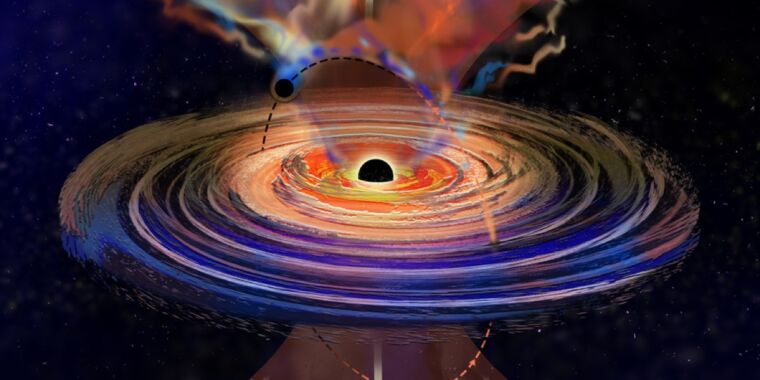Unraveling the Mystery of a Galactic Light Burst
In December 2020, astronomers were perplexed by an extraordinary burst of light emanating from a galaxy located approximately 848 million light-years away. This galaxy housed a supermassive black hole at its core that had remained relatively dormant until this event. The surge of energy displayed a peculiar pattern, with intermittent dips occurring roughly every 8.5 days, reminiscent of celestial hiccups that captivated the scientific community.
The Discovery
Recently, researchers have uncovered the underlying cause behind this enigmatic behavior. They have identified the presence of a smaller black hole orbiting the supermassive black hole, which intermittently intersected the larger black hole’s accretion disk during its trajectory, resulting in the release of gas plumes. This revelation challenges the conventional belief that black hole accretion disks exhibit uniform characteristics, as elucidated in a new study published in the prestigious journal Science Advances.
One of the co-authors of this study, Dheeraj “DJ” Pasham from MIT’s Kavli Institute for Astrophysics and Space Research, was instrumental in unraveling this cosmic enigma. Pasham seized the opportunity to observe the galaxy of interest using the X-ray telescope NICER (Neutron star Interior Composition Explorer) aboard the International Space Station, following the detection of the light flare named ASASSN-20qc by the All Sky Automated Survey for SuperNovae (ASAS-SN). Over a span of four months, Pasham meticulously collected and analyzed X-ray data, uncovering a consistent 8.5-day periodicity in the energy bursts, akin to the transient dimming of a star when an orbiting planet traverses its path.
Theoretical Insights and Collaborative Endeavors
Pasham’s investigation into this intriguing phenomenon led him to a theoretical postulation by Czech physicists, proposing the existence of an orbital configuration involving a supermassive black hole and a companion black hole, capable of producing the observed periodic fluctuations. This theoretical groundwork laid the foundation for collaborative efforts that culminated in the validation of this extraordinary hypothesis through computational simulations leveraging the NICER data. The central black hole in the galaxy, estimated to possess a mass equivalent to 50 million suns, exhibited no prior bursts before December 2020, indicating a minimal accretion disk presence, possibly shielded by a smaller black hole ranging from 100 to 10,000 solar masses.
The Dynamic Cataclysmic Event
The pivotal turning point occurred in December 2020 when a nearby star succumbed to the gravitational forces of the supermassive black hole, resulting in its disintegration—the phenomenon known as a tidal disruption event (TDE). This catastrophic episode triggered the formation of an accretion disk around the black hole, emitting intense X-rays and visible light indicative of a TDE eruption. Subsequent observations revealed a substantial accretion disk luminosity, attributed to the disrupted star, which injected unprecedented quantities of gas plumes when traversed by the smaller orbiting black hole, aligning fortuitously with the observation telescope’s orientation.
Challenging Preconceived Notions
This groundbreaking discovery has expanded our comprehension of binary black hole systems, deviating from traditional paradigms. Pasham eloquently articulated this new paradigm, highlighting the perplexing intricacies of objects penetrating and traversing the accretion disk from diverse angles, defying conventional principles governing gaseous disk dynamics around black holes. This anomalous configuration, termed a “David and Goliath” binary black hole system, portends a vast reservoir of similar entities waiting to be unveiled within the cosmic fabric.
Image/Photo credit: source url





